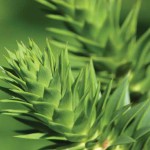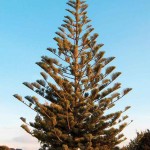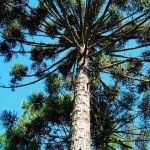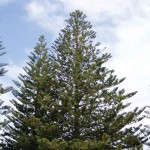Oliver Thornwhistle on—Araucaria
I feel fortunate that my vocation offers me low-altitude air travel to the four corners of Guatemala. When I’m in a helicopter or small plane, or even at a window on an upper floor of a Zone 10 high rise in Guatemala City, I invariably carry away two impressions: Quauhtlemallan, from the 16th century Nahualt for “land of trees,” is still verdantly heavily forested, despite the sickening depredations in the Petén; and there is a spectacular dominant tree throughout the Highlands.
Chances are you have seen one or, if living anywhere in the Highlands, you have one within blocks of your house: Its genetic material has survived intact for 23 million years, since the early Miocene era, through ice ages, asteroid strikes and drought.
It flourishes in New Zealand and Chile and as far north as the Faroe and Queen Charlotte Islands. And right here in Guatemala.
Its seed pods weigh up to 20 pounds. There are boy trees and girl trees, although they have to wait for their 40th birthday to make little trees.
There are distinct species within the family, and the family has its very own non-conformist Bart Simpson.
Chances are you have known the araucaria, my favorite tree, by a common name such as star pine, Norfolk Island pine, etc.
The araucaria has spread throughout Guatemala and distinguishes itself through perfect symmetry, branches radiating from the trunk in perfect order. Since it grows routinely to 100 feet or more, it is not hard to spot, and its habit of bifurcating, or splitting its trunk, makes it often even more visible.
It must wait about 40 years to reproduce. I can imagine an in-search-of ad, “Boy/girl tree seeks girl/boy mate. Must be at least 40 and perfectly symmetrical. Object, long life together, millions of offspring.”
When I say “long life together” I refer to the fact that scientists now believe that the araucaria can live to 1,000 years of age. As a family it has already lived for 23 million years, so what’s a few more? There are many species, as many as 15 possibly in Guatemala, and one variety can reproduce only with a mate from the same. Trees are pollinated by the wind, birds and insects, and the task of finding a suitable same-sex/same-species mate seems daunting—lots of takeoffs and landings only to find that the target is the wrong variety or sex.
The odd man out, as if it says “Symmetrical? Not me,” which I think of as the Bart Simpson of the family, is the bidwilli or Bunya Bunya, whose complete disregard for symmetry earned it the moniker the Monkey Puzzle tree. (Only a monkey could sort this out.)
Araucaria seed pods weigh 15 to 20 pounds, and can easily take out a car windshield or your own pate. Bugs eat the individual seeds, as do squirrels, birds and aborigines.
Where to find araucaria in Guatemala? Step out the door, chances are there is one in sight. But the absolutely primo spot is Guatemala City’s general cemetery, where the trees drop cones in June.
My dream is that a reader will plant a stand of araucaria, similar species in rows to further the dating game. I’ll help provide the breed stock.




Nice article about beautiful Araucarias. Just to clarify some botanical facts. Even though Araucarias are planted in Guatemala they are NOT native to our country. These evergreens are native to the southern hemisphere. There are just THREE species reported to be here in Guatemala: A. heterophylla (which sometimes is referred as A. excelsa), A. bidwillii and A. cunninghamii. A. bidwillii has wider leaves and has huge female cones. Some nice mature trees can be found at Universidad Landívar (zone 15) and Universidad Francisco Marroquín’s arboretum (zone 10) both in Guatemala City.